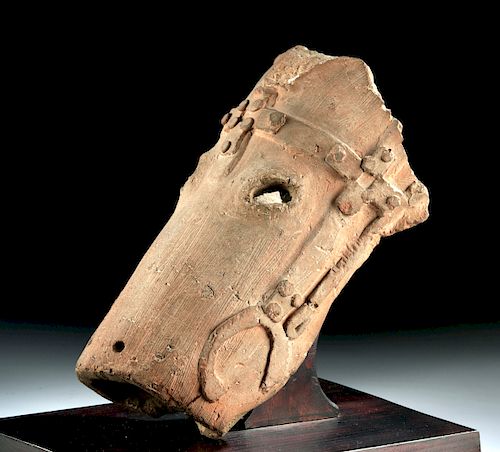Rare Japanese Haniwa Terracotta Horse Head
Lot 138a
About Seller
Artemis Gallery
686 S Taylor Ave, Ste 106
Louisville, CO 80027
United States
Selling antiquities, ancient and ethnographic art online since 1993, Artemis Gallery specializes in Classical Antiquities (Egyptian, Greek, Roman, Near Eastern), Asian, Pre-Columbian, African / Tribal / Oceanographic art. Our extensive inventory includes pottery, stone, metal, wood, glass and textil...Read more
Categories
Estimate:
$3,500 - $5,000
Absentee vs Live bid
Two ways to bid:
- Leave a max absentee bid and the platform will bid on your behalf up to your maximum bid during the live auction.
- Bid live during the auction and your bids will be submitted real-time to the auctioneer.
Bid Increments
| Price | Bid Increment |
|---|---|
| $0 | $25 |
| $300 | $50 |
| $1,000 | $100 |
| $2,000 | $250 |
| $5,000 | $500 |
| $10,000 | $1,000 |
| $20,000 | $2,500 |
| $50,000 | $5,000 |
| $100,000 | $10,000 |
| $200,000 | $20,000 |
About Auction
By Artemis Gallery
Sep 26, 2019
Set Reminder
2019-09-26 10:00:00
2019-09-26 10:00:00
America/New_York
Bidsquare
Bidsquare : Exceptional Day 1: Antiquities & Asian Art
https://www.bidsquare.com/auctions/artemis-gallery/exceptional-day-1-antiquities-asian-art-4437
Day 1 of an important 2-day auction featuring exceptional, museum-worthy examples of Egyptian, Greek, Etruscan, Roman, Viking, Russian, Near Eastern, as well as Asian Art from China, Japan, Thailand, Vietnam, Burma and India. Artemis Gallery info@artemisgallery.com
Day 1 of an important 2-day auction featuring exceptional, museum-worthy examples of Egyptian, Greek, Etruscan, Roman, Viking, Russian, Near Eastern, as well as Asian Art from China, Japan, Thailand, Vietnam, Burma and India. Artemis Gallery info@artemisgallery.com
- Lot Description
Eastern Asia, Japan, Kofun Period, ca. 450 to 600 CE. One of my absolute favorite items, this is a buff-brown hollow pottery horse head. It wears a fancy bridle with large round bit plates, depicted in relief on the face, and likely once had a finial at the center of the forehead that is now lost. The face has openwork eyes and a round, tubular snout with open mouth end. It would also have once had large ears, a tall mane, and a full, saddled body. This style of figure is known as "haniwa", meaning "clay cylinder" or "circle of clay" in Japanese. Although they were stylized and often similar in appearance, the bridle form shows some personal touches. Size: 6" W x 10.35" H (15.2 cm x 26.3 cm); 11.25" H (28.6 cm) on included custom stand.
Haniwa are large, hollow, earthenware funerary objects, which were placed atop large mounded tombs known as "kofun", which means "old tomb". These tombs are such a hallmark of this prehistoric time period that it takes its name from them. This horse head is the type of funerary good made to be seen - they were placed to mark the open surfaces of the huge tombs, which were denuded of trees, covered with gravel arranged in artistic designs, and surrounded by moats. Haniwa like this horse were made by hand (rather than cast), and the most care in making them was given to human figures and horses. In this time of heavy armed conflict, horses were crucial companions and signs of wealth. Horses had only recently been domesticated in Japan, making them extra special for the Kofun.
See a similar example at the Metropolitan Museum of Art (69.249) and a full Haniwa horse at LACMA (M.2008.102).
Provenance: private J.H. collection, Beaverton, Oregon, USA
All items legal to buy/sell under U.S. Statute covering cultural patrimony Code 2600, CHAPTER 14, and are guaranteed to be as described or your money back.
A Certificate of Authenticity will accompany all winning bids.
We ship worldwide and handle all shipping in-house for your convenience.
#149693This is a fragment from a larger sculpture. The edges are rough and one area near the top of the head has been repaired. Small losses, chips, nicks, and scratches commensurate with age. However, the form and detail that are present are beautifully preserved.Condition
- Shipping Info
-
All shipping is handled in-house for your convenience. Your invoice from Artemis Gallery will include shipping calculation instructions. If in doubt, please inquire BEFORE bidding for estimated shipping costs for individual items.
-
- Buyer's Premium



 EUR
EUR CAD
CAD AUD
AUD GBP
GBP MXN
MXN HKD
HKD CNY
CNY MYR
MYR SEK
SEK SGD
SGD CHF
CHF THB
THB














